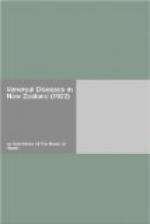The causes of the spread of venereal disease may be classified under two main headings: (1) The presence of infected individuals acting as foci of infection; (2) the occurrence of promiscuous sexual intercourse, by which in the great majority of cases the disease is actually transmitted from one individual to another.
(1.) The Presence of Infected Individuals.
These sources of infection arise and persist for the following reasons:—
(1.) Neglect by infected persons to undergo treatment. (2.) Neglect to continue treatment till no longer infective. (3.) The treatment of infected individuals by unqualified persons, such as chemists, herbalists, chiropractors, &c. In these cases the disease becomes chronic, and the best opportunity for its treatment and cure has passed before the case is seen by a medical man. (4.) By the introduction of venereal disease to this country from overseas.
(2.) The Occurrence of Promiscuous Sexual Intercourse.
A striking portion of the evidence placed before the Committee was that which showed the very small amount of professional prostitution in New Zealand. This was supported by the valuable evidence of Mr. W. Dinnie, ex-Commissioner of Police, and Mr. A.H. Wright, Commissioner of Police. The latter witness stated that there were only 104 professional prostitutes in the Dominion.
It would appear also that the professional prostitute, as a result of her knowledge and experience, is less likely to transmit venereal disease than the “amateur.” It is therefore principally to clandestine or amateur prostitution that one must look for the dissemination of the disease, and inquiry into the conditions which tend to the production of the amateur prostitute is a direct inquiry into the causes of the prevalence of venereal disease.
The evidence before the Committee shows that this promiscuity is very prevalent, and that it is not confined to any particular social strata. The fact is also strikingly demonstrated by Table A in the appendix. From this table it will be seen that during the period 1913-21 there were 10,841 illegitimate births and 33,738 legitimate first births within one year after marriage. If to the illegitimate births we add the total number of live births occurring within the first seven months of marriage viz., 12,235—which may be safely considered to have been conceived before marriage, we get a total of 23,076 births in which conception took place extra-maritally. In other words, more than 50 per cent. of total first births occurring within twelve months of marriage result from sexual contact prior to marriage.
Some factors which contribute in a greater or less degree to the moral laxity which leads to promiscuous sexual intercourse are:—




